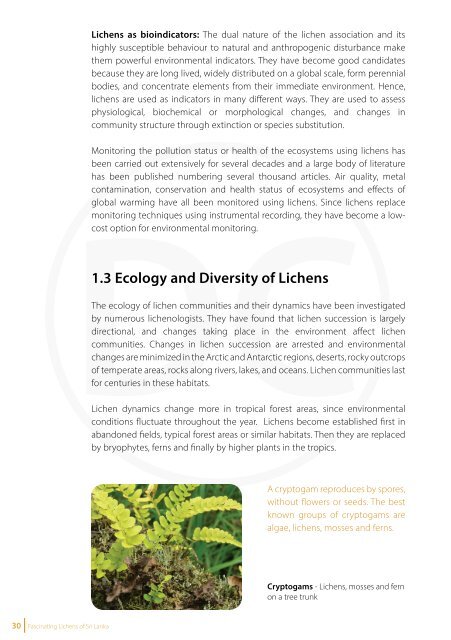You also want an ePaper? Increase the reach of your titles
YUMPU automatically turns print PDFs into web optimized ePapers that Google loves.
<strong>Lichens</strong> as bioindicators: The dual nature <strong>of</strong> the lichen association and its<br />
highly susceptible behaviour to natural and anthropogenic disturbance make<br />
them powerful environmental indicators. They have become good candidates<br />
because they are long lived, widely distributed on a global scale, form perennial<br />
bodies, and concentrate elements from their immediate environment. Hence,<br />
lichens are used as indicators in many different ways. They are used to assess<br />
physiological, biochemical or morphological changes, and changes in<br />
community structure through extinction or species substitution.<br />
Monitoring the pollution status or health <strong>of</strong> the ecosystems using lichens has<br />
been carried out extensively for several decades and a large body <strong>of</strong> literature<br />
has been published numbering several thousand articles. Air quality, metal<br />
contamination, conservation and health status <strong>of</strong> ecosystems and effects <strong>of</strong><br />
global warming have all been monitored using lichens. Since lichens replace<br />
monitoring techniques using instrumental recording, they have become a lowcost<br />
option for environmental monitoring.<br />
1.3 Ecology and Diversity <strong>of</strong> <strong>Lichens</strong><br />
The ecology <strong>of</strong> lichen communities and their dynamics have been investigated<br />
by numerous lichenologists. They have found that lichen succession is largely<br />
directional, and changes taking place in the environment affect lichen<br />
communities. Changes in lichen succession are arrested and environmental<br />
changes are minimized in the Arctic and Antarctic regions, deserts, rocky outcrops<br />
<strong>of</strong> temperate areas, rocks along rivers, lakes, and oceans. Lichen communities last<br />
for centuries in these habitats.<br />
Though lichens play a dominant role in terrestrial communities, knowledge <strong>of</strong><br />
their community ecology as relevant to remote areas, especially in inaccessible<br />
Polar Regions and many <strong>of</strong> the tropical areas, is limited. About 18,000 lichens have<br />
been recorded so far while the current estimation remains as 28,000. Estimates<br />
agree that half <strong>of</strong> the global estimation, 14,000 lichens, is entirely harboured in<br />
the tropics.<br />
The appearance <strong>of</strong> lichen communities is similar in wide geographical areas <strong>of</strong><br />
the world while the species composition varies from region to region. Certain<br />
lichens are found to be restricted to specific substrates (the surface on which<br />
lichens are attached). Some lichen groups are cosmopolitan and become<br />
established in specific communities.<br />
<strong>Lichens</strong> are most striking in arctic and alpine environments, as they <strong>of</strong>ten<br />
form extensive carpets on the ground and colourful crusts on rock surfaces.<br />
Comparatively, lichens tend to be inconspicuous in tropical environments,<br />
except in some mountain forests, which are festooned with fruticose lichens.<br />
<strong>Lichens</strong> on organic substrates (bark, leaf surface) are most diverse in the tropics,<br />
while lichens on rocks are poorly represented. The tropical primary forest canopy<br />
is an unexplored frontier for lichen survival.<br />
The significance <strong>of</strong> lichens in the tropics is not immediately obvious. Not enough<br />
attention has been given to their biodiversity. Most <strong>of</strong> the tropical areas still<br />
remain under-explored or unexplored.<br />
Lichen dynamics change more in tropical forest areas, since environmental<br />
conditions fluctuate throughout the year. <strong>Lichens</strong> become established first in<br />
abandoned fields, typical forest areas or similar habitats. Then they are replaced<br />
by bryophytes, ferns and finally by higher plants in the tropics.<br />
A cryptogam reproduces by spores,<br />
without flowers or seeds. The best<br />
known groups <strong>of</strong> cryptogams are<br />
algae, lichens, mosses and ferns.<br />
Cryptogams - <strong>Lichens</strong>, mosses and fern<br />
on a tree trunk<br />
Old car covered with<br />
various lichens<br />
Although lichenized fungi are better known than other fungi, there are significant<br />
geographical and taxonomic gaps in the tropics. A geographical analysis <strong>of</strong><br />
lichen checklists suggests that most missing species will be found in the tropics<br />
and the southern hemisphere.<br />
Knowledge <strong>of</strong> tropical lichens is crucial for the accurate estimation <strong>of</strong><br />
global lichen richness.<br />
30 <strong>Fascinating</strong> <strong>Lichens</strong> <strong>of</strong> <strong>Sri</strong> <strong>Lanka</strong><br />
<strong>Fascinating</strong> <strong>Lichens</strong> <strong>of</strong> <strong>Sri</strong> <strong>Lanka</strong> 31















